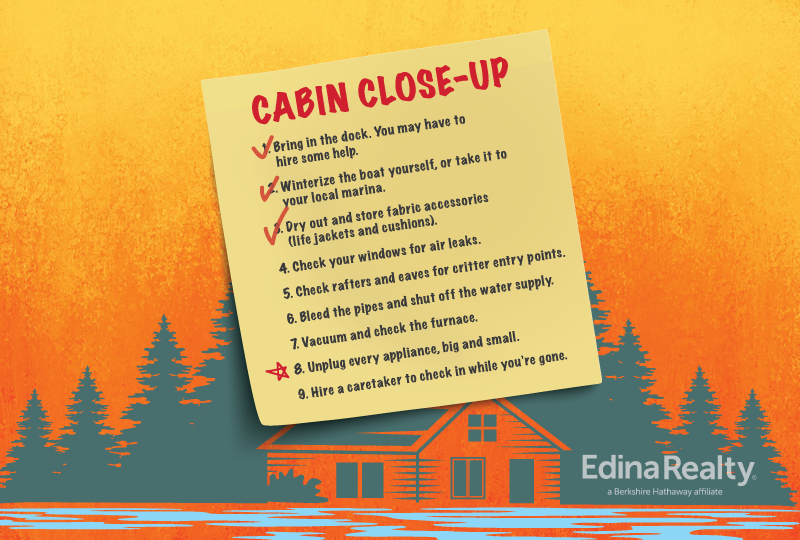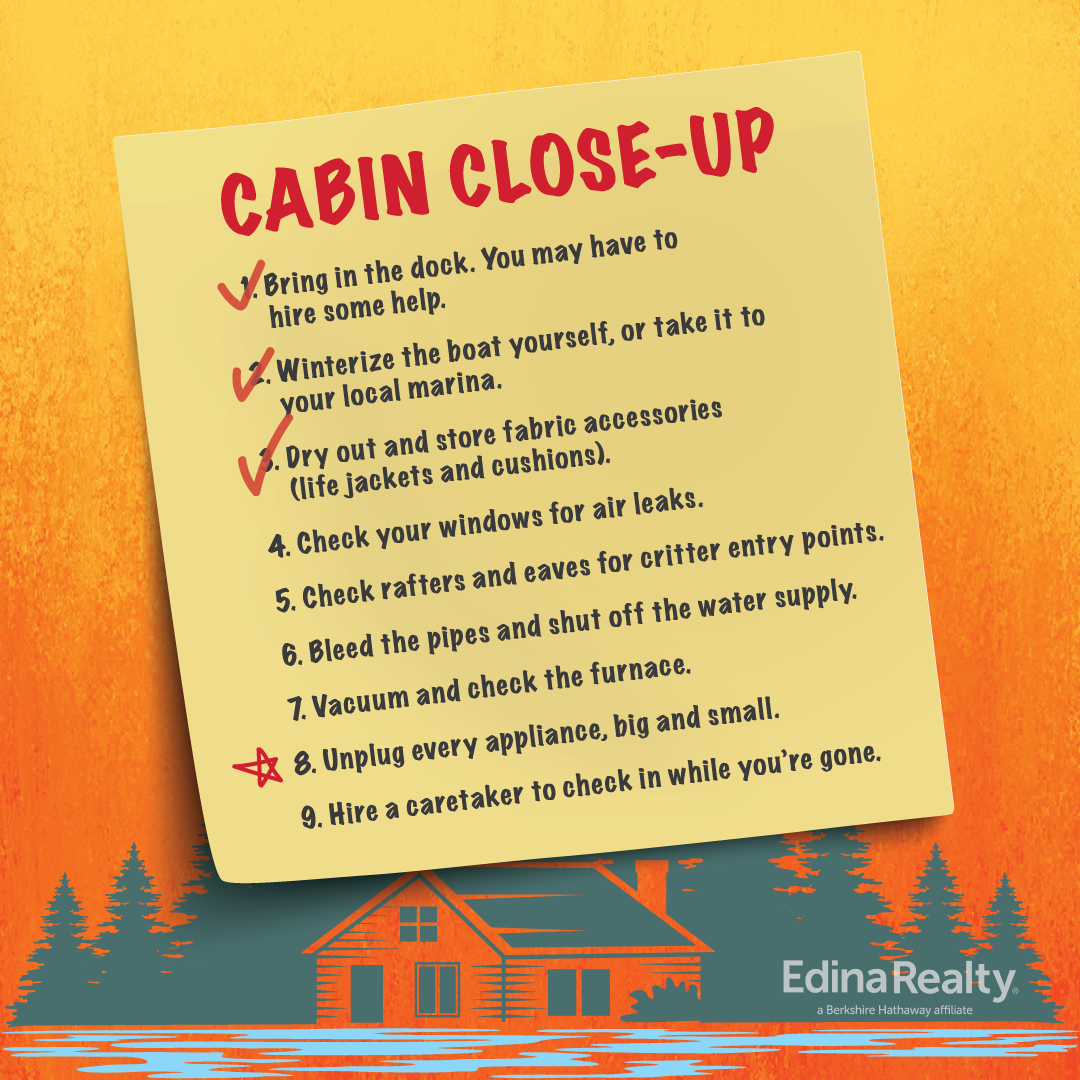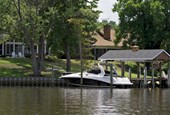
Key Insights
- It’s important to properly store and clean up your cabin before you close it for the season.
- Take care to winterize both your outdoor property, like boats and 4-wheelers, as well as your standing structures, like sheds and cabin.
- Prevent winter damage by storing items, checking on appliances and windows and unplugging appliances.
Closing up your lakeshore cabin is never as exciting as opening it up, but it’s important to protect your waterfront property during the off-season.
Follow these nine steps as you close up your cabin for the winter:
- Bring in the dock. You may have to hire some help.
- Winterize the boat yourself, or take it to your local marina.
- Dry out and store fabric accessories (life jackets and cushions).
- Check your windows for air leaks.
- Check rafters and eaves for critter entry points.
- Bleed the pipes and shut off the water supply.
- Vacuum and check the furnace.
- Unplug every appliance, big and small.
- Hire a caretaker to check in while you’re gone.

1. Bring in the dock
Unless you have a dock that can withstand ice or have installed a “bubbler” to help prevent ice from forming, you’ll need to remove your dock at the end of the summer season. Start by cleaning the dock off and packing up all the accessories (including rope, storage containers, tie-ups and more). Then, the tricky work of removal and storage can begin.
Roll-in-and-out docks and floating piers should take 2-3 people, but you’ll have to call in reinforcements if you have a standing dock. If you aren’t sure you can handle the responsibility yourself, consider hiring a true expert. Many lake towns have local companies that specialize in installing and removing waterfront equipment, including docks, boat lifts and boats. You’ll want to call now to get on their docket before the cold weather rolls in.
2. Winterize the boat
If you’re a rookie boat owner, you may not know how to winterize your boat — a process that includes flushing the engine, disengaging the battery, replacing the oil and more. To winterize your boat, you can:
- Follow your boat’s manual.
- Review and follow this 10-step general process.
- Hire your local marina or boat storage facility.
Last, remember to cover the boat securely or get it professionally shrink-wrapped to protect it from the elements.
3. Store cushions, rafts and life vests
You’re used to drying out bathing suits and towels at the end of each weekend, but now it’s time to dry out everything made of fabric, including:
- Outdoor furniture cushions
- Boat cushions
- Life vests and wetsuits
- Pontoon canopies
- Tubes, blow-up rafts, water mats
- Flags and other decorations
Start the process of collecting these items early in your long weekend, and set them out to dry in a sunny area. To prevent mildew, make sure these items are 100% dry before you store them in a well-ventilated area.
4. Check for window leaks
Shake windows to see if they rattle. If the frames aren’t secure, add caulk to the perimeter to seal them off. Next, test each window’s ability to close and lock — especially if they’ve been open or unlocked all season. Chip off any paint or debris that prevents the windows from closing and locking tightly.
5. Check corners, roof and eaves for entry points
Check corners, floorboards, eaves and other nooks and crannies for holes, keeping in mind that adult mice only need a hole the size of a dime to squeeze in. Seal up any gaps using steel wool, which mice and squirrels cannot chew through. Last, don’t forget to check behind refrigerators, ovens, beds and other objects that don’t get moved often. Those are the most common places for small holes to go unnoticed — and the most likely entry points for critters once you’ve left for the season.
6. Turn off the water and plumbing
If you plan to shut down the cabin for the entire winter, you’ll want to bleed the pipes and shut down plumbing completely. Begin by shutting off your main water valve, then follow these tips from This Old House to make sure you cover all your bases. Remember, too, to look beyond your indoor plumbing; you’ll also want to shut off your outdoor water valve and drain and store your hoses and other outdoor water equipment for winter.
7. Check the furnace
If you don't need heat for the entire winter, turn the furnace off. Vacuum the inside and check its filter to ensure it’ll be up and running in the early spring months. If you don’t have any replacement filters on hand, order them now and have them delivered to your primary residence. Your early-spring-cabin-fever self will thank you.
8. Unplug all appliances
Start with the kitchen and move through every room to be sure that nothing is plugged in. Don’t forget to check behind couches for power strips, and include larger appliances that you may have to move out from the wall, including:
- Ranges
- Microwaves
- Refrigerators
- Washers and dryers
Last, have someone check your work — this is a great job for eager kiddos!
9. Hire a “check-in” caretaker
If you have a friend or neighbor who stays in town year-round, ask them to check in on your place from time to time. You’ll rest easier if you know that someone is alerting you to suspicious activity and checking the interior for water damage or critter invasions. If it’s not a close friend, be sure to offer compensation so the caretaker is motivated to honor the deal.
Prep for spring. Buy now!
If you buy a lakeshore home or cabin now, you won’t miss even one day on the water next spring. Browse lake homes and cabins for sale in Minnesota and western Wisconsin. See one you want to reel in? Contact Edina Realty or your agent to get started.








 ©2025 Prosperity Home Mortgage LLC®. (877) 275-1762. 3060 Williams Drive, Suite 600, Fairfax, VA 22031. All first mortgage products are provided by Prosperity Home Mortgage, LLC®. Not all mortgage products may be available in all areas. Not all borrowers will qualify. NMLS ID #75164 (For licensing information go to: NMLS Consumer Access at
©2025 Prosperity Home Mortgage LLC®. (877) 275-1762. 3060 Williams Drive, Suite 600, Fairfax, VA 22031. All first mortgage products are provided by Prosperity Home Mortgage, LLC®. Not all mortgage products may be available in all areas. Not all borrowers will qualify. NMLS ID #75164 (For licensing information go to: NMLS Consumer Access at